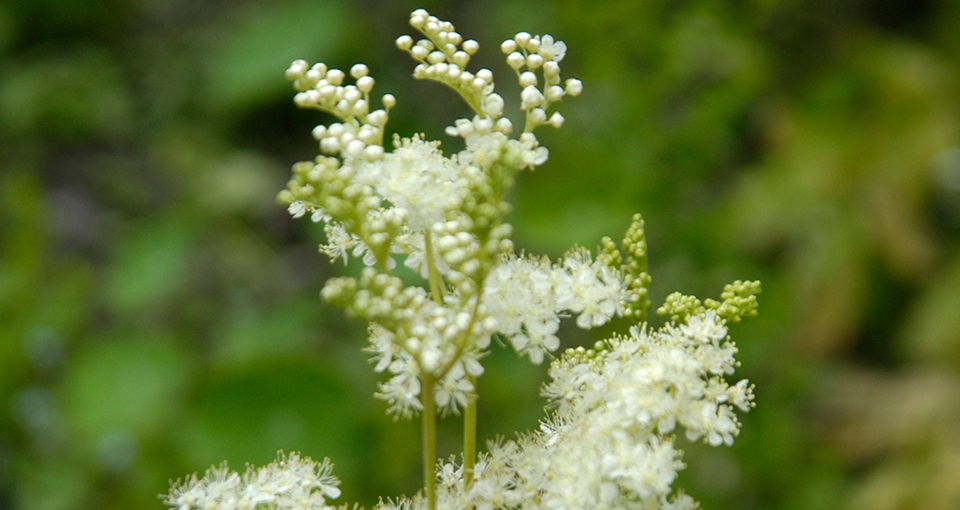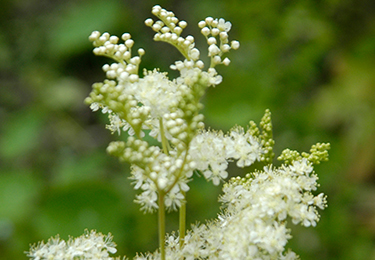
Watchlist
You can print out your watchlist and use it as a reminder for your purchase in the pharmacy.
Your watchlist currently contains no products.
Print


Meadowsweet blossoms
Meadowsweet blossoms
Botanik
Meadowsweet (Filipendula ulmaria L.) belongs to the Rosaceae family. It is often found on wet meadows and alluvial forests, in marshes and water banks of the northern temperate zone. The spread area reaches from northern Siberia, the Altai and eastern Mongolia to Asia Minor into the northern Balkan-countries, Great Britain, Scandinavia, South-Italy, France as far as Spain.
Meadowsweet is a long-sprout herbaceous perennial with short, thick rootstock. The rather inconspicuous, creamy white flowers exude a wonderful vanilla fragrance in summer.
mehr
Geschichte
How the meadowsweet came to its name has not been finally clarified. It was used to flavour mead. Today's name could therefore come from the term "mead sweet". Already with the Celts the meadowsweet was considered a holy plant and was worshipped because of the various application possibilities. It is said to have an invigorating and purifying effect on our blood. Meadowsweet is also known as "meadow queen" or "Spiraea". What hardly anyone knows: The brand name Aspirin is derived from this name, because the research of meadowsweet was the basis for the development of Aspirin. Although Aspirin is synthetic, the original form in meadowsweet is natural and native.
mehr
Inhaltsstoffe
The smell of meadowsweet flowers, especially at flowering season, is due to the ingredient salicyl methyl ester (spiraein). In addition to salicyl methyl ester, the flowers of meadowsweet also contain salicyl aldehyde and above all flavonoglycosides and ellagitannins. A herbal heparin was also found in meadowsweet flowers [Kudriashov et al. 1990, 1991].
Lit.: Kudriashov et al.: The content of a heparin-like anticoagulant in the flowers of the meadowsweet (Filipendula ulmaria). Farmakol. Toksikol. (1990)
mehr
Eigenschaften
Especially the salicylaldehyde contained in its flowers as well as the salicylic acid methyl esters are converted into salicylic acid in our liver. [1,2] This inhibits the formation of prostaglandin and, together with flavonoids which are also contained, has a fever-reducing, anti-inflammatory and pain-relieving effect. [2]
Meadowsweet flowers also contain vegetable-bound heparin, which has blood-thinning and fibrinolytic properties, as it inhibits the coagulation cascade in two different ways: it binds to the protease inhibitor antithrombin III, which circulates in the blood and thus binds and inhibits coagulation factors such as thrombin and factor Xa, which are already activated about a thousand times faster. In addition, heparin reduces the number of free calcium ions in the blood by binding. The calcium ions required as cofactors for the blood coagulation cascade are then no longer available. In addition, the fibrinolytically active serine protease Kallikrein is activated by heparin.[3, 4] This results in thrombosis prophylaxis as a further field of application. This is not only relevant for chronic venous diseases, but also for people who suffer from lack of exercise, have a long flight in front of them or have to inhibit blood coagulation due to a stroke or heart attack.
1. Hänsel R, Sticher O, Steinegger E (2010) Pharmakognosie, Phytopharmazie, 9., überarbeitete und aktualisierte Aufl. Springer-Lehrbuch. Springer Medizin, Heidelberg
2. Blaschek W (2014) HagerROM 2014: Hagers Enzyklopädie der Arzneistoffe und Drogen Wissenschaftliche Verlagsgesellschaft, Stuttgart
3. Kudriashov BA, Ammosova IM, Liapina LA et al. (1991) Heparin from the meadowsweet (Filipendula ulmaria) and its properties. Akad Nauk SSSR Biol(6): 939–943
4. Kudriashov BA, Liapina LA, Azieva LD (1990) The content of a heparin-like anticoagulant in the flowers of the meadowsweet (Filipendula ulmaria). Farmakol Toksikol 53(4): 39–41
mehr
Produkte mit Meadowsweet blossoms
Mädesüßblüten Dr. Pandalis Bio Tee
Organic Dr. Pandalis Meadowsweet Tea

Veneo 093® Bio Tabletten
Veneo 093® bio Tablets
